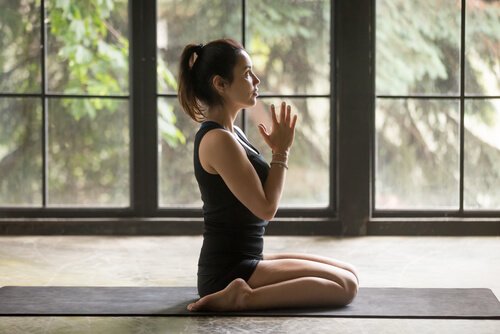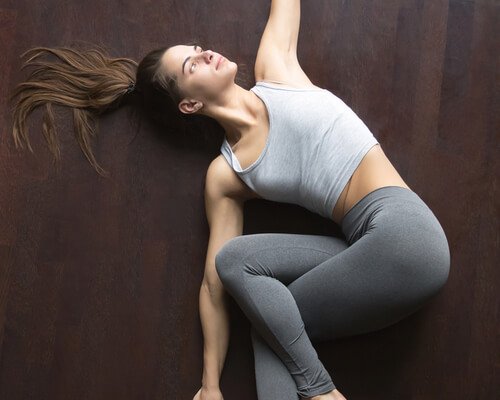4 Yoga Poses for a Better Night's Sleep

People who have insomnia and perform daily yoga techniques to try and sleep better experience all kinds of sleep benefits. They fall asleep faster in the first place, get a longer night’s sleep, and fall asleep again more easily if they wake up in the middle of the night.
If you want to practice yoga to try to sleep better, what you really need to do is listen to your body. You shouldn’t push yourself beyond what your body can handle, or perform any exercise that could cause you pain.
Entities such as the European Society of Cardiology recommend that patients with sleeping difficulties practice yoga for an hour a day. The researchers claim that practicing yoga daily can prevent the development of hypertension. In addition to this, it has been shown that yoga can also help reduce stress.
Read on and discover some of the best yoga poses for fighting insomnia.
4 yoga poses for a better night’s sleep
Yoga may not solve your sleep problems immediately. However, if you practice it every day before going to bed you will notice how it improves the quality of your sleep. You will be a lot more relaxed and it will reduce the stress levels in your life. This will allow your mind to be clearer, enabling you to rest better when you go to bed.
Here are the four yoga poses we’ve selected for you.
Hero or Virasana
Although its name may seem to indicate totally the opposite, this is one of the best poses to help you relax. We recommend that you spend several minutes in the Hero pose before going to bed. The first thing you need to do is sit on the floor Japanese style, with your knees bent and your lower legs turned backwards.

The surface of your feet should be resting flat on the ground. At the same time, your spine has to remain straight, with your shoulders and head aligned with the hips. If this puts too much pressure on your knees, place a pillow between your feet and rest your buttocks on it.
The hero pose is ideal for reaching a state of complete well-being. It will help you feel physically healthy and emotionally stable. This is because sitting in this position stimulates pressure points on the surface of the feet that promote total relaxation of the body.
Corpse or Savasana
This second pose is especially useful to help you to center your mind. By doing it, you can “reconnect” with your breathing, get in tune with your body, and release your daily stress. As in the previous exercise, we recommend that you do the corpse pose just before going to sleep, as it will help you get a better night’s sleep.
First of all, you should lie on your back with your feet at a distance from your hips and relax your arms at your sides. Then, raise the palms of your hands and close your eyes. While doing this, take a few breaths, and inhale and exhale slowly.
After doing this for several seconds, you will notice how relaxed you feel.
Spinal twist or Jathara Parivartanasana
If stomach problems keep you awake during the night, then we recommend practicing the spinal twist pose. This exercise will help relieve a swollen stomach and the retention of gases. In addition, it will improve your circulation and relieve tension in the neck and back area.
First of all, you need to lie on the floor face up. As you extend your arms, bend your knees and bring them close to your chest. Then, move them to the right side of your body with your left shoulder touching the ground. After that, turn your head to the left. Press down on your knees with the right hand for a more effective stretch.
Hold this position and count up to 6, inhaling and exhaling gently as you count. After this, repeat the sequence for the left side of your body to complete the full exercise.

Legs-up-the-wall or Viparita Karani
At the end of your working day, especially if you’re on your feet most of the day, your feet and ankles can swell and feel fatigued. This exercise is very useful for this, as it helps regulate your blood flow.
First of all, place a yoga mat on the floor in an area near the wall with plenty of space. Place your back on the mat, and raise your legs upwards and lean them against the wall. Stretch your arms out at the sides of your body, and breathe deeply. You can practice this exercise for as long as you need.
In conclusion, yoga is considered one of the best treatments for insomnia because it helps to relax the body and mind. If you start doing these yoga poses regularly, you should get considerable sleep benefits as you reduce the tension and stress in your life.
This text is provided for informational purposes only and does not replace consultation with a professional. If in doubt, consult your specialist.








